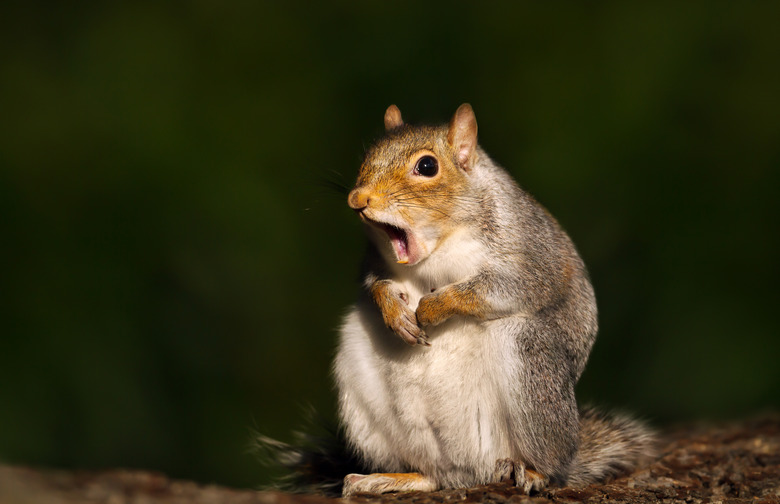How To Make Friends With A Squirrel
Squirrels are a familiar group of common animals with bushy tails. Over 200 species of squirrels exist worldwide, on every continent except Antarctica and Australia (save for those in zoos and a small escapee population of palm squirrels near Perth).
Squirrels share their forest habitat more and more with humans, and squirrels and humans interact frequently with each other.
About Squirrels
About Squirrels
Squirrels are in the family of rodents called Sciuridae. This family also includes marmots, chipmunks, woodchucks and prairie dogs. There are many species of squirrels around the world, including species of tree squirrels, ground squirrels and flying squirrels.
Examples of squirrel species that live in North America are the red squirrel, grey squirrel, Arctic ground squirrel, striped squirrel and black squirrel.
Read more about the different types of squirrels.
Most squirrels are modest in size compared with other mammals. For example, the common North American gray squirrel is a medium-sized squirrel, measuring up to 20 inches in length. Squirrels, like all rodents, have four front teeth that are constantly growing, and therefore the animals have a strong need to gnaw on hard materials like wood.
Squirrels are not difficult to find in forests and backyards across North America. Squirrels are easy to recognize because of their long, bushy tails. Many species of squirrels are crepuscular, meaning they are animals that are active during twilight and can be most easily found at dawn or dusk.
What Squirrels Eat
What Squirrels Eat
Squirrels are omnivores, which means they eat food from both plant and animal sources. Squirrels eat a variety of plant foods such as nuts, berries, leafy greens and roots. Squirrels also will consume fungi, eggs, insects, caterpillars and other small animals.
When presented with human food scraps, squirrels do not tend to be picky eaters. They enjoy cereal, bird seed, the occasional bit of meat, and dog and cat food.
Squirrels don't like spicy foods such as raw garlic, onions or peppers, and can even be deterred from vegetable gardens using pepper spray. While squirrels might prefer human foods, some of these foods are not good for squirrels. Foods that squirrels should not eat include dairy products, chocolate, candy, highly processed food, other junk food or sugary cereal.
Squirrels in Captivity
Squirrels in Captivity
While it is inappropriate (and in many cases, illegal) to try to capture and domesticate any healthy wild animal, sometimes sick or injured squirrels are in need of human intervention and care. In some cases baby squirrels are abandoned or rejected by their mother and can be rehabilitated by humans.
If you find a squirrel that appears orphaned or injured, it is best to contact your local wildlife rehabilitation organization or a local veterinarian. It is important to remember that a wild squirrel may be afraid, agitated or sick, and that you should seek the advice of a professional before giving care to a wild animal.
Even after rehabilitation, a wild squirrel in captivity will never actually be a tame squirrel, and it should be cared for and handled by trained professionals.
Squirrel Care
Squirrel Care
If for some reason you do find yourself in care of a squirrel, be advised that baby squirrels have more particular needs than adult squirrels. Baby squirrels are born blind and are dependent on their mothers for two to three months. Baby squirrels in captivity need to be fed formula at first as they cannot eat solid food until about eight weeks of age.
Baby squirrels need to be kept warm, such as with a heat lamp or heat pad, as they can't digest their food when they are cold. Stay in contact with a wildlife rehab organization to ensure you're following the best practices possible for caring for the squirrel.
Adult squirrels have similar needs to other small domestic rodents such as guinea pigs or gerbils. A pet squirrel cage should be 3 to 8 feet high to allow plenty of climbing room for the squirrel. A pet squirrel cage should be clean and have newspaper or cedar shavings to cover the floor.
The pet squirrel cage also should also contain fresh water (ideally in a small animal water bottle), wood to gnaw on and privacy (which can be in the form of fabric draped over the cage).
Squirrels for Sale
Squirrels for Sale
While squirrels might be cute and fluffy, they are indeed wild animals and should not be a first choice when choosing a pet.
In most states, keeping a wild squirrel as a pet is illegal, although in some cases you can apply for a permit or wildlife rehabilitation license if you find yourself in care of an injured or orphaned squirrel. It is best to check the laws of your state if you are interested in buying a tame squirrel from a breeder to be kept as a pet.
When looking into gray squirrels for sale (or other squirrel varieties), it is important to buy from a reputable squirrel breeder as they are more likely to be tame and healthy squirrels. You might also see varieties of squirrels for sale at exotic pet shops in your area.
Before purchasing any tame squirrel from a breeder, be sure to acquire any necessary permits from your state.
References
- WhatDoSquirrelsEatorg: What Do Squirrels Like to Eat?
- SquirrelNutrition.com: How to Get Squirrels to Be Friendly
- FeedingNature.com: 6 Essential Tips for Keeping Squirrels as Pets
- Live Science: Squirrels: Diet, Habits and Other Facts
- ABC News: The Rise and Fall of Perth's Palm Squirrel Pest Population
- Metro News: Bet You Can't Guess What This Squirrel Was Caught Tucking Into
Cite This Article
MLA
Reinbold, Joan. "How To Make Friends With A Squirrel" sciencing.com, https://www.sciencing.com/befriend-squirrel-2060755/. 22 November 2019.
APA
Reinbold, Joan. (2019, November 22). How To Make Friends With A Squirrel. sciencing.com. Retrieved from https://www.sciencing.com/befriend-squirrel-2060755/
Chicago
Reinbold, Joan. How To Make Friends With A Squirrel last modified March 24, 2022. https://www.sciencing.com/befriend-squirrel-2060755/
